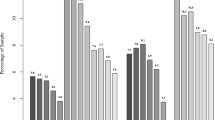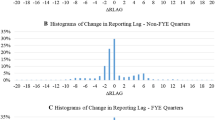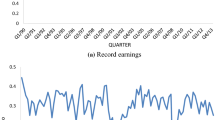Abstract
Finance literature highlights various reasons for stock performance subsequent to earnings announcements. However, other moving parts in these scenarios must also be simultaneously specified. While both revenue and earnings surprises are important for determining stock performance, forward-looking guidance and firm valuation prior to earnings should also be considered. Additionally, analyses that solely consider market-level data miss important subtleties evident in a sector-specific study, as “normal” growth and valuation metrics across sectors widely differ. We differentiate between firms that announce earnings during the evening hours (after the close) and firms that announce earnings during the morning hours (prior to the open).

Similar content being viewed by others
Notes
Unlike revenue, EPS values (estimates and actuals) can be negative, which does not allow for a calculation of percent change. To account for this, scaled earning surprise is calculated as the ratio of EPS Surprise $ / Prior Closing Price. This ratio, as opposed to EPS Surprise $, is utilized in order to introduce a standardized metric that accounts for market value.
References
Alwathnani AM, Dubofsky DA, Al-Zoubi HA (2017) Under-or-overreaction: market responses to announcements of earnings surprises. Int Rev Financ Anal 52:160–171
Arellano M (1987) Computing robust standard errors for within-groups estimators. Oxf Bull Econ Stat 49:431–434
Bagnoli M, Clement M, Watts S (2004) Around-the-clock media coverage and the timing of earning announcements. University of Texas at Austin, Working Paper
Berkman H, Truong C (2009) Event day 0? After-hours earnings announcements. J Account Res 47(1):71–103
Bhojraj S, Hribar P, Picconi M, McInnis J (2009) Making sense of cents: an examination of firms that marginally miss or beat analyst forecasts. J Financ 64(5):2361–2388
Carhart MM (1997) On the persistence in mutual fund performance. J Financ 52:57–82
Fama EF, French KR (1993) Common risk factors in returns on stocks and bonds. J Financ Econ 33:3–56
Fama EF, French KR (1996) Multifactor explanations of asset pricing anomalies. J Financ 51:55–84
Froot K, Kang N, Ozik G, Sadka R (2017) What do measures of real-time corporate sales say about earnings surprises and post-announcement returns? J Financ Econ 125(1):143–162
Jegadeesh N, Livnat J (2003) Post-earnings-announcement drift: the role of revenue surprises. Financ Anal J 62(2):22–34
Livnat J, Mendenhall RR (2006) Comparing the post--earnings announcement drift for surprises calculated from analyst and time series forecasts. J Account Res 44(1):177–205
Mian GM, Sankaraguruswamy S (2012) Investor sentiment and stock market response to earnings news. Account Rev 87(4):1357–1384
Patell J, Wolfson M (1982) Good news, bad news, and the intraday timing of corporate disclosures. Account Rev 57:509–527
Shanthikumar, D. M., (2003). Small and large trades around earnings announcements: does trading behavior explain post-earnings-announcement drift? SSRN
Skinner DJ, Sloan RG (2002) Earnings surprises, growth expectations, and stock returns or don’t let an earnings torpedo sink your portfolio. Rev Acc Stud 7(2–3):289–312
White H (1980) A heteroscedasticity-consistent covariance matrix estimator and a direct test for heteroscedasticity. Econometrica 48:817–838
Acknowledgements
This work is supported by the Sam Houston State University COBA Summer Research Grant Program. We would like to thank the participants at the 2019 Academy of Economics and Finance annual conference (St. Pete Beach, FL) for their helpful comments and insight. We would also like to thank Darien Kearney and Amy Beth Thomas for excellent research assistance.
Author information
Authors and Affiliations
Corresponding author
Additional information
Publisher’s note
Springer Nature remains neutral with regard to jurisdictional claims in published maps and institutional affiliations.
Rights and permissions
About this article
Cite this article
Alvarado, J.I., Clark, L.C. & Gutierrez, J.A. Stock performance subsequent to combinations in quarterly revenue surprise, earnings surprise, guidance, valuation, and report time. J Econ Finan 45, 95–117 (2021). https://doi.org/10.1007/s12197-020-09531-7
Accepted:
Published:
Issue Date:
DOI: https://doi.org/10.1007/s12197-020-09531-7




